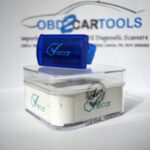Navigating the world of automotive diagnostics can be complex, but bidirectional OBD scanners are designed to simplify the process, offering advanced capabilities for both professionals and DIY enthusiasts. You might be wondering about the essentials of using these powerful tools. Here, we address your frequently asked questions to clarify how bidirectional OBD scanners can enhance your vehicle maintenance and repair experience.
Demystifying Bidirectional OBD Scanner Use
Many users inquire whether utilizing a companion app is mandatory for their OBD scanner. The answer is no. While apps like RepairSolutions2 can significantly augment your diagnostic experience by providing ASE-verified repair guidance, exportable scan data, predictive repair insights, and access to technical service bulletins, they remain entirely optional. Think of these apps as valuable assistants, not prerequisites, for effective vehicle diagnostics with your bidirectional scan tool.
Cost is often a concern, particularly regarding updates and subscriptions. Rest assured, updates for your bidirectional OBD scanner are free of charge, and there are absolutely no subscription fees involved. Investing in a bidirectional scanner is a one-time purchase that continues to provide value without recurring costs.
Geographical compatibility is another common question. While bidirectional OBD scanners are engineered to support a broad spectrum of vehicles, including domestic, foreign, and Asian models, their operational range is typically within North America—the United States and Canada. For residents of Mexico, compatibility is limited to US-imported vehicles due to adherence to North American OBD protocols. It’s crucial to verify regional compatibility to ensure your tool functions as expected.
Vehicle compatibility is paramount. Bidirectional OBD scanners are designed to be universally compatible with most OBD2-compliant vehicles. However, the extent of features accessible can vary based on your vehicle’s year, make, and model. To confirm compatibility and feature availability for your specific vehicle, it’s always recommended to use a coverage checker tool provided by the manufacturer. This step ensures that your bidirectional scanner will effectively communicate with your vehicle’s systems.
For owners of FCA vehicles (like Jeep or Chrysler), bidirectional OBD scanners offer comprehensive diagnostics on systems of models manufactured in 2017 or earlier. For newer FCA vehicles (2018 and newer) requiring AutoAuth access, functionalities such as TPMS relearn and live data are available. However, due to limitations in accessing AutoAuth without specialized tablets like the Innova 7111, certain functions such as code erasing, oil resets, and battery initialization may be restricted on these newer models when using standard handheld or dongle bidirectional scanners. For full access to all features on modern FCA vehicles, consider tools that support AutoAuth.
A crucial point to understand is the scope of a bidirectional OBD scanner’s capabilities. These tools are powerful for diagnostics and active testing, allowing you to send commands to your vehicle to test components. However, they are not designed for reprogramming vehicle computers or key fob programming. These more complex tasks often require specialized equipment and software beyond the scope of standard bidirectional OBD scanners.
Finally, it’s important to note the operational prerequisites for using a bidirectional OBD scanner. These devices necessitate that the vehicle is at least able to crank, if not fully start. Bidirectional scanners communicate with the vehicle’s Electronic Control Units (ECUs), which requires the vehicle’s electrical system to be at least partially functional. If a vehicle cannot start or crank, the scanner will be unable to establish the necessary connection with the ECU to perform diagnostics or bidirectional tests.
Conclusion: Embracing Bidirectional Diagnostics
Bidirectional OBD scanners are invaluable tools for anyone seeking deeper insights into their vehicle’s health and performance. Understanding their capabilities and limitations, particularly regarding vehicle compatibility, feature availability, and operational requirements, ensures you can leverage their full potential for effective automotive diagnostics and maintenance. By addressing these common questions, we aim to empower you to confidently utilize bidirectional OBD scanners for your automotive needs.


